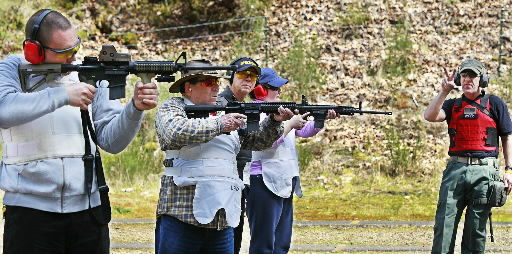Applications close Monday for the annual Citizens’ Police Academy, a free 10-week program that provides a look into how local law enforcement and the court systems operate.
The academy covers police operations such as SWAT, patrol, street crimes and drug units, as well as how police hire and train officers. Longview Police Sgt. Doug Kazinsky said the academy also includes a live-fire range training, where citizens can handle police weapons, and a 3-hour police ride-along.
The academy gives citizens a chance to walk in the shoes of law enforcement officers.
“We show them the things they pay for with their taxpayer dollars,” Kazinsky said.
The academy is a regular collaboration among the Kelso and Longview Police Departments and the Cowlitz County Sheriff’s Office. Kazinsky said it’s been going on for about 20 years.
In addition to police operations, the academy walks students through the judicial system as well, offering students a chance to ask prosecutors, defense attorneys and judges questions about the inner workings of the courts.
Classes will be held from 6 to 9 p.m. every Wednesday for 10 weeks, plus one Saturday in April. Applicants must pass a background check.
“We typically cap it at about 30, 35 people, but we had almost 60 applicants last year,” Kazinsky said. “We hope to get everyone in that applies, (but) unfortunately we had to turn away some people last year.”
Kazinsky said the academy has seen a similar response this year, which he attributes to an increased attention on law enforcement nationally.
“For Longview, for example, the police department is a third of the city budget,” Kazinsky said. “There’s just an increased interest in government accountability and law enforcement.”
The citizen’s police academy is a chance for citizens and police to learn from each other, Kazinsky said. Recently, popular discussion topics have included police tactics such as use of force and differences in sentencing lengths for crimes of similar nature.
“There’s always an interest in just how the police process works,” Kazinsky said.
Towards the end of the course, students are put in a split-second decision-making simulation to see how quickly police may have to react to stressful situations.
In the simulation, students are given a “simunition” gun, which fires small paint pellets. They’re given a request for a typical call, like a suspicious person or vehicle prowl. Then, Kazinsky said, reserve deputies play the roles of the people involved, and students are presented with a situation where they have to decide whether or not to use force, deadly or otherwise.
“Maybe the guy’s armed, maybe he’s really upset and starts getting animated, maybe he’s really elusive and hiding his hands or weapons,” Kazinsky said. “... It’s just to be illustrative of how we have to take in a lot of peripheral information at one time.”
The exercise, which includes a breakdown afterwards of how often force is used by police departments, is an eye-opener for students, Kazinsky said.
“They always say, ‘I can’t believe how fast that happened,’” he said.






Post a comment as
Report
Watch this discussion.
(0) comments
Welcome to the discussion.
Log In
!!!CHANGES TO ONLINE COMMENTS — PLEASE READ BEFORE POSTING!!!
Effective immediately, all comments will display the user's FIRST AND LAST NAME rather than a screen name. Anyone with an existing account that did not provide a first and last name when registering will be required to update their profile before submitting a comment. AGAIN - YOUR ACCOUNT MUST INCLUDE A FIRST AND LAST NAME!
Keep it Clean. NO obscene, vulgar, lewd, racist or sexually-oriented language.
PLEASE TURN OFF YOUR CAPS LOCK.
Don't Threaten. Threats of harming another person will not be tolerated.
Be Truthful. Don't knowingly lie about anyone or anything.
Be Nice. No racism, sexism or any sort of -ism that is degrading to another person. Comments that include verbal attacks of another commenter will not be posted.
Be Proactive. Use the 'Report' link on each comment to let us know of abusive posts.
Share with Us. We'd love to hear eyewitness accounts, the history behind an article.